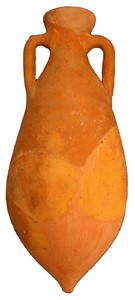Roman Amphorae: a digital resource
University of Southampton, 2005. (updated 2014) https://doi.org/10.5284/1028192. How to cite using this DOI
Data copyright © University of Southampton unless otherwise stated
This work is licensed under the ADS Terms of Use and Access.
Primary contact
Dr
David
Williams
Dept of Archaeology
University of Southampton
Avenue Campus
Highfield
Southampton
SO17 1BJ
England
Tel: 080 593032
Resource identifiers
- ADS Collection: 463
- DOI:https://doi.org/10.5284/1028192
- How to cite using this DOI
Bónis 31/5

Courtesy of Dr. Ottó Sosztarits, Savaria Museum
Tamás Bezeczky
Distinctive FeaturesThe rim is chalice-shaped, the neck is short, the body is bag-shaped and ends in a very small stub. The handles are attached to the neck below the rim horizontally, and reach the upper part of the body almost vertically. Their cross section is round. The shape is very similar to Dr 6B but the size is smaller.See characteristics | ||
Date RangeFrom the early first to the second centuries ADSearch: [1st century AD] [2nd century AD] | ||
OriginUnknownSearch: [Unknown] | ||
DistributionThis amphora type was found in northern Italy, Noricum, Pannonia and Moesia: Aquileia, Emona, Flavia Solva, Poetovio, Savaria, Carnuntum, Baláca and VindobonaSearch: [Central Europe] [Italy] [North West Europe] [The Balkans] | ||
ContentsUnknown.Search: [Unknown] | ||
CommentsPrincipal contributor: Tamás Bezeczky |



 3D models
3D models


